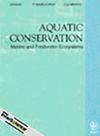Behavioural Processes Underlying the Habitat Selection of Indo-Pacific Bottlenose Dolphins (Tursiops aduncus) in the Ningaloo Marine Park and Exmouth Gulf, at the North West Cape, Western Australia
Abstract
Identifying the behavioural processes influencing habitat use is important for understanding a species' behavioural and spatial ecology and informing their conservation. In this study, we collected information on the behavioural state of globally Near Threatened Indo-Pacific (IP) bottlenose dolphins (Tursiops aduncus) inhabiting coastal waters at the North West Cape (NWC), Western Australia (WA). Ensemble habitat suitability modelling was used to identify key environmental and anthropogenic variables correlated with the spatial distribution of dolphin groups engaged in foraging, travelling and resting behaviours to determine whether dolphins use particular areas for such activities. The distribution of foraging groups was related to distance from the nearest boat ramp and seabed slope, with the foraging dolphins more likely to occur 3000–5000 m from the nearest boat ramp and in areas of moderate seabed slope. Resting dolphins were localised and most likely to occur in shallow waters (5–10 m deep) within designated Sanctuary Zones of the Ningaloo Marine Park (NMP). Dolphins travelling were more likely to occur 1000–2000 m from the coast and in water depths of 7–12 m but as deep as 20 m. The integration of behavioural data into habitat suitability models allowed the identification of areas of biological importance for IP bottlenose dolphins at the NWC. Given the increasing risks to dolphins from cumulative anthropogenic activities in this region, the results from this study are applicable for marine spatial planning and adaptive management of this Near Threatened dolphin species.

 求助内容:
求助内容: 应助结果提醒方式:
应助结果提醒方式:


